|
November 17, 04,
The Value Of More Uniform Nitrogen NH3 Application.
Guy Swanson, Author, Steve Peterson Indiana Producer.
Factors that affect the rate and type of nitrogen recommended by an
agronomist for a corn crop.
1.
Yield Goal
2.
Residual nitrogen based on soil sampling or soybean yield maps.
3.
Soil type.
4.
Organic Matter contribution or CEC of the soil and soil pH.
5.
Tillage Systems having compacted soil layers or No-tillage
systems having well drained soils.
6.
Manure credits
7.
Seed Row N
8.
N applied with herbicide.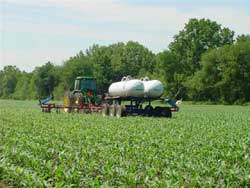
9.
Uniformity of Application
10.
Timing of Application.
11.
Variety Selection.
12.
Dual product application.
13.
Availability of the nitrogen source
14.
Cost of the nitrogen source.
15.
The need for other major and minor nutrients.
16.
Stable nitrogen vs. mobile nitrate solution fertilizer.
Scientific evaluation factors that affect
the algorithm for pounds of N per bushel using NH3 as the nitrogen
source. After two years of testing Exactrix is .7 to .8 pounds of total
N per bushel…the university recommendation in the corn belt varies from
1.1 to 1.2 pounds of total N per bushel.
1.
Uniformity of the application. A 1% C to a 50% CV
2.
Timing of the application. Fall vs. spring pre-plant, planter
applied or side dress.
3.
Band spacing. 60” to 10”
4.
Depth of the band. 2.5” to 12”
5.
Positional relationship of the nitrogen band with the corn row.
Directly under, to the side or mid-row, indexed and double side banded
to the row.
6.
Tillage system. Shank application to single disc application.
Factors that affect the machinery
selected to apply NH3.
1.
Soil type
2.
Tillage system or a No-till, Ridge-till system. Strip tillage
considered.
3.
Machinery that affords the best timing for the crop production
schedule.
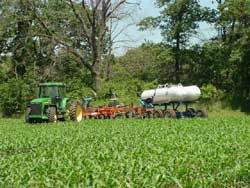
4.
The temperature at the time of application.
5.
The width of the applicator.
6.
The desire to side dress and pre-plant apply.
7.
The desire to apply NH3 with VRT.
8.
Dual application techniques improving NPK and S efficiency, which
requires narrow band spacing.
9.
Other crops in the rotation such as wheat that requires narrow
band spacing.
10.
Injection of Nitrogen stabilizers into the NH3 flow.
There are three key factors that affect
the economic risk of applying NH3. Several types of application
variability do occur in the application management of nitrogen as NH3.
Field Rate, Band Rate, and the Lineal Sinusoidal Rate.
First Key
Factor: Regarding the field applied rate as indicated by the
controller.
1.
The bulk density is changing constantly. A 30 degree F spread
between early morning and late afternoon means a 7% change in the actual
N rate per acre.
2.
The first 2/3 of tank will have a small temperature variation.
The last 1/3 of the tank will have a significant temperature drop. A
volumetric application will have a 3% to 7% variation due to the change
in the bulk density from the top of tank to the bottom of the tank.
Since NH3 must be pushed out the tank energy is required. The energy
required can be measured in the change in bulk density or the
temperature of the material in the tank.
3.
The turbine type flow meters have a +-3% variation across the
flow range. If the application is made primarily in one flow range then
the calibration number can be adjusted but VR-N becomes very difficult.
4.
Because the tank valve began to close at a high flow rate or the
cooler could not keep up at the high flow rate. Stretched NH3 of a
lighter bulk density or partial gas flow state through the turbine flow
meter indicated liquid flow…..But a much lower bulk density.
5.
Defective tanks with broken siphon tubes or damaged tank valves
with poor excess flow internal valves. Blocked or plugged tank siphon
tubes are common. Poor tank valves and cracked welded delivery siphon
tubes are common creating tremendous variability in the per acre applied
rate.
Second Key Factor: Regarding the
band rate which is masked in the operators mind as the per acre rate.
The band rate is the most critical rate.
1.
The band rate can be measured with buckets of water. The CV can
be as high as 50% as per Hnatowich in Saskatchewan.
The shank is installed into a 5 gallon
water bucket complete with the delivery tube. The bucket should have
about 25 pounds of water. Since 90% of the pressure reducing systems
have a cooler the vent tubes are also installed into the dedicated band
buckets. About 6% of the total NH3 flow is vented through the cooler.
Aqua Ammonia is formed in the water buckets as the metering system is
activated delivering NH3. Guess Row Return side dress buckets at 50%
rates are also captured in the bucket. After about 5 minutes the
application of NH3 into the buckets is stopped and buckets are weighed
with a very accurate counting scale.
A CV calculator is used to develop the
system application CV. Thus the system has been measured… not just the
manifold. The Coefficient of Variation is a dimensionless number made
with an exponential calculation. The calculation is a measurement of
variability, uncertainty with a 95% chance that the event measured will
occur again. It is a measurement of economic risk once a dollar value is
added to total amount of N applied e.g. $40 per acre of N is applied
with a 30% CV indicates that $12 per acre is wasted and only $28 per
acre applied was effective.
2. With
the best pressure reducing manifolds available as tested at ISU in one
ideal flow range…. The application CV is between 27% to 35%. Why?
Because of the cooler contribution to the CV at 8% to 10%…. The shank
delivery tube CV at 10% to 12% and the Guess Row return CV at 9%…. Plus
the manifold CV which you can select from the ISU manifolds tested chart
which can be from 7% to 23%.
As the flow range changes the ISU tested
pressure reducing manifolds are volume sensitive and not pressure
sensitive because of the two state flow. Thus as the flow changes
the regulation CV of the manifold changes…. Making VRT impossible since
the CV is not predictable in all flow ranges. The tests did indicate
high variability in all flow ranges. Application rates in VR-N are
adjusted in several management zones by a factor of 6 times the lowest
rate. So application can be from 40 pounds of N to 240 pounds of N per
acre.
3. The
condition of the shank drilled outlet ports are constantly changing. A
10% CV is considered good when new. Measurements made at ISU indicate
the CV can be above 50% when the shanks are used. Thus the gas state
and liquid state flow or two phase flow follows the path of least
resistance contributing to a greater application CV.
4. Delivery
tubes do plug since the NH3 is freezing the shank. Mud builds up around
the ports and changes the application CV. A partially plugged delivery
tube allows other delivery tubes to receive more flow. Since pressure
reducing systems are only volume sensitive systems…. Flow can not be
controlled to the high degree of accuracy required for VRT and reduced
use of the material.
5. NH3
pressure reducing systems deliver NH3 steady by jerks. This can be
easily observed by watching the bouncing needle of the manifold pressure
gauge or installing a pressure gauge in the shank delivery line. This
is due to the constant change of equilibrium in the two state flow
system. A steady pressure gauge needle would be a good indication of
non-interrupted flow as created by the shank.
Third Key Factor: Regarding the
lineal band rate (sine wave) is hidden from the operator, the scientist,
the agronomist. Over the length of a 100 foot band the variation of NH3
can be as high as 50% CV. The sinusoidal, pressure reducing NH3
application geometry or location is only known to the growing crop.
Some areas of the lineal band are too hot (high pH, oxidizer) and some
areas are not adequate.
1. The
application sine wave at high CV means that the concentration of NH3 can
be 4 to 5 times higher in one column area of a lineal band as compared
to an adjoining column area in the same band. Micro core samples can be
taken to confirm this, Circa, John Moraghan, NDSU. If the NH3 column is
too concentrated the fine hair roots are damaged (oxidized) and colonize
around the hot spot which has a stable pH of 9.5. The damaged
(oxidized) hair roots never penetrate into the core of the high NH3
concentration. This small amount of placed NH3 is lost to the
environment.
2. The
best way to measure the NH3 application sine wave in a lineal band is to
use a growing crop such as corn. Scientists can compare this by using
Aqua Ammonia and compare it to Anhydrous Ammonia. Aqua Ammonia always
outperforms NH3 since up to 30% less Aqua Ammonia 20-0-0 is required as
tested in the PNW. This also explains why placed P is more efficient
with Aqua Ammonia since the hot spots in the lineal band are reduced.
Aqua ammonia is always delivered with flooded manifolds using orifice
plates that have a 6% to 10% CV. Excellent pictures showing stranded
nitrogen and damaged (oxidized) hair roots due to excessive NH3 band
concentration are available from the Ron Rickman of the USDA-ARS-Pendleton.
3. Another
way to test lineal band variation (sine wave) is to apply with a
pressure reducing NH3 system at a low, mid and high rate and then cross
compare to a liquid, high pressure injection, of NH3 using an Exactrix
system.
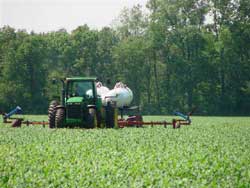
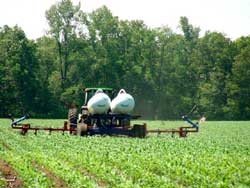
Stated and understood by the writer and
reader…..It would be better to test pressure reducing NH3 improved
manifold systems that have non tested system CV’s by comparing to an
Exactrix system with a tested system CV.
As we progress in our understanding that
the only way to test and compare any NH3 delivery system is to set up
a series of crop plots using the same applicator, tractor, and operator
to compare high pressure liquid injection of NH3 with the improved
pressure reducing manifolds. Thus the variability of two application
machines is taken away.
This has been
done in Indiana this year.
Producer Steve Peterson used a Hiniker control and a Hiniker cooler
system to meter NH3 through an Impellicone developed by Iowa State and
licensed to John Blue. The Impellicone or Equa-flow has an ISU tested 6%
CV to 6.9% CV in two flow ranges.
System Applying, NH3
Application,Yield, Nutrient Cost, CostN/Bu, Gross Return, Gross Margin
% of Gross Marginal Dollar Return
Pounds
N/A. Bu./A $.25 N, $/A centsN/Bu. $/Bu@$1.75/Bu N-Gross
$N/$Gross MRP, MEY
Exactrix
180 189 45
23.80 330.75 285.75 13.60 $5
invested lost $6.00 at MEY
Hiniker,Impellicone
180
186 45
24.19 325.50 280.50 13.82 $5
invested lost $10.50 at MEY
______________________________________________________________________________________________________________________
Exactrix
160 192 40
20.83 336.00 296.00 11.9 MEY
$10.00 invested gained $19.75_Compared
to MRP
Hiniker, Impelllicone 160 182 40
21.97 318.50 278.50 12.56
$17.50/A lost at MEY
______________________________________________________________________________________________________________________
Exactrix
140 185 35
18.91 323.75 288.75 10.81 $5
invested above MRP net gain $1.00
Hiniker, Impellicone 140 182 35
19.23 318.50 283.50 10.99 $5
invested above MRP net loss $3.25
______________________________________________________________________________________________________________________
Exactrix
120 181 30 16.57
316.75 286.75 9.47 MRP $10.00/A not
invested for MEY,Lost
$19.25/A. Last $1= $2
Hiniker,Impellicone
120 165 30 18.18
288.75 258.75 10.39 Net Loss $28/A
At the Marginal Return Point, MRP,
Exactrix outperformed the Hiniker Cooler Impellicone system by 16
bushels per acre or $28 per acre.
At the Maximum Economic Yield, MEY,
point….well beyond the point of diminishing returns Exactrix produced
$17.50 or 10 more bushels per acre of corn at 160 pounds N as compared
to the Hiniker Cooler Impellicone pressure reducing NH3 system.
In all application ranges Exactrix was
better.
The plots were randomized and replicated
three times. The highest yield was 193 bushels per acre with Exactrix
at the 180 pound N/A rate. The lowest yield was 156 bushels per acre
with the Hiniker Cooler Impellicone/Equa-flow applying 120 pounds of
N/A.
At $1.75 per bushel corn at
Shelbyville, IN this comes to a difference of $28.00 per acre. The
Impellicone with the installation charges came to about $1,000…..A 2KC
Exactrix system comes to $21,542 with a controller that can also be used
on a sprayer.. Steve is not a big producer…. average in size. Steve has
750 acres of corn on corn. That is $21,000 of additional income using
the Exactrix. Yields were in the 180 bushel per acre range. Over 10
Years about $200,000 additional income could be generated.
Also Steve did not apply the plots below
120 pounds of N per acre….Therefore the MRP was not truly identified.
Based on other plots and 40% more available N with the Exactrix it is
apparent that the MRP was 100 pounds N per acre in a corn on corn
rotation. The plots were side dressed with no Guess Row Return.
Producers have 40% more crop available
Exactrix nitrogen…..Producers can use less NH3 and raise more corn…..or
producers can raise more corn in very good crop years using lower
rates. Steve used an Exactrix model 2KFT applying with a shank type
applicator on 30” band centers. Steve uses a tillage system.
Results could be better with No-tillage
single disc openers applying on 15-in. centers using leverage fertility
and side dressing techniques.
Results could be better with an Exactrix
model 2KC or 2KD using Coriolis Mass Flow adding an additional $3.75 per
acre advantage at the higher rates and $2.00 per additional advantage at
the lower rates. Mass Flow systems have 3% lower CV than the 2KFT and
deliver NH3 with .003 to .006 accuracy in all flow, temperature and
pressure ranges. The Exactrix 2KC and 2KD systems also inject at 200%
higher pressures and 141% greater volumes.
The field applied rate and the band rate
are improved with the 2KC and 2KD justifying further economic
investigation of Coriolis Mass Flow systems for corn producers in the
2,000 acre size. As NH3 prices increase and corn prices remain the same
or go lower the 2KC and 2KD Coriolis Mass Flow system becomes more
attractive to smaller producers.
Other factors
that can reduce application efficiency with pressure reducing NH3
systems not shown in the Peterson test.
1. Application
temperature dramatically effects cooler efficiency. As application
temperatures range between 40 degrees F and 32 degrees F the cooler is
no longer effective. The latent heat of expansion of NH3 is greatly
reduced which means the cooler is unable to maintain a liquid state flow
to the turbine flowmeter. The cooler vent tubes begin to emit more
liquid flow of NH3. In fact the typical vented flow of NH3 can exceed
12% of the total flow.
2. Slope
angle in the range of 10% to 30% creates irregular band patterns using
pressure reducing NH3 application systems. The uphill side of the
applicator ports receives less flow than the downhill side of the
applicator ports. This is a critical factor in the western Corn Belt as
tested by the University of Nebraska, Lincoln. Slope angle creates a
higher CV with a Skew pattern. Slope angle has been tested with Exactrix
indicating that compound angle slopes of 65% (30 degrees) to angled
slopes of 50% (26.3 degrees) can be effectively applied with Exactrix
pressure increasing liquid NH3 injection system. The Exactrix liquid NH3
injection pressure is up to two times greater (250 psi) than the tank
pressure.
Cultural factors that can reduce the
need for applied N shown in the Bange test.
Technical advancements in No-tillage
farming using low soil disturbance, high speed, single disc application
openers (Bourgault MRB) have shown that applied nitrogen requirements of
the crop are reduced. In a no-till, ridge-till corn soybean rotation
applied N as NH3 at 40 pounds N per acre did produce a 253 to 262 bushel
per acre average irrigated corn yield in randomized and replicated
plots. The soybeans contributed 60 pounds of N with a uniform
distribution of organic nitrogen from the legume. The balance of
nitrogen was supplied by the mineralized Organic Matter or OM. Using .8
pounds of N per bushel produced the mineralizing OM contributed 108
pounds of N per acre due to the 7 year no-tillage system.
Hoxie, Kansas producer Ray Bange has
proven for two years in a row that the OM is contributing 40 pounds of N
per 1% of OM. The soil pH is 7.6 pH. The soil is center pivot irrigated.
In Bange’s case it is not possible to raise the OM above 2% in the
no-till rotation with soybeans and corn. Thus the soil microflora are
breaking down the OM much faster than the typical 20 pounds of N per 1%
of OM. Ray Bange is raising crops in the fencerow. In otherwords the
soil is healthy and in equilibrium with the growing crop.
Further results from Exactrix
producer test plots including the Bange test plot
will be explained in the Exactrix No-Till Nutrient Management seminar
December 7, 04 at Aurora, Nebraska and the seminar at Garden City,
Kansas December 9, 04.
Guy Swanson
ASAE, ASA, ASM, WSDA Certified
Exactrix Global Systems
Spokane, Washington USA
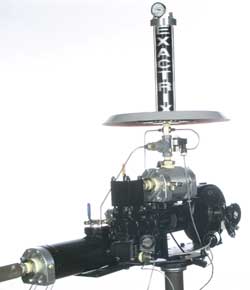
2KF Volumetric |
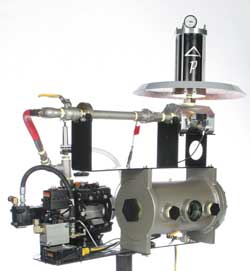
2KM Liquid Dual Placement |
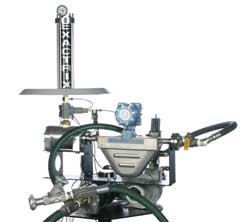
2KC Coriolis Mass Flow |
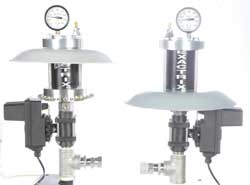
2KM Mini-Man Manifold |
|